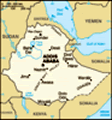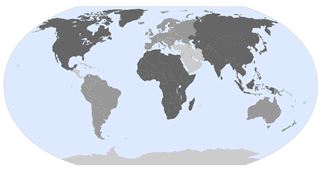Advertisement
Published: February 3rd 2010
We can't say that we weren't warned. Other travellers told us that the Omo Valley would be a lousy experience. Our Dragoman leaders warned us not to expect too much in terms of interaction. Our expectations of the Omo Valley and the visits to the tribes living in the Valley were low as we travelled in through the beautiful scenery. I was prepared to be disappointed but I wasn't quite so prepared to be angry.
The Omo is home to a number of tribal people of Ethiopia together known as the Southern Tribal Peoples. It is the home of the Mursi people - famous for the practice of its women in placing increasingly large labrets in their lips - and of a dozen or so other tribes including the Ari, Hamer, Tsamai and Bana, that are distinctly different and identifiable. These are people who clearly hold hard to their traditions and their culture and must have a very strong desire to maintain it for as long as possible. The people are so different that they are of great interest to people from other places and they have long been the subject of scrutiny - whether they liked it or not.
We learnt at the Southern Omo Research Center Museum a little about the peoples of the Valley. I wont try to set it out here. If you are interested have a look at the web site for the Center or for the Mursi people. There may be sites dedicated to the other tribal groups as well. What was clear from the material provided by the Centre was that the people would prefer a different way of interacting or dealing with tourists.
Dragoman seems to be a pretty responsible and sensitive tour company. Certainly, our experience of its leaders is of people who have a great deal of respect for the countries they travel through and the peoples with whom they interact. The Omo has roads that are too rough for the Dragoman truck and, to get in and around, we were off-loaded into Toyotas operated by the Green Land company. This is a large Ethiopian company with an apparently good reputation for its experience and delivery. We travelled around the Valley for 5 days and, throughout, the drivers impressed with their driving skill and care. We were very much less impressed by the way the company set up

 Blacksmith
Blacksmith
In the Ari Village. The daughter wanted in.our 'interaction' with the people we visited.
But I should really give a description of what went on rather than get set for a rant.
As you head along the road into the Omo there are increasing numbers of people, mainly kids, on the side of the road begging for money, plastic bottles, water (Highland is the tipple of choice), caramelo (sweets or lollies) and mastica (chewing gum). As we moved into the Valley the kids performed more. They did dances, callisthenics, Michael Jackson routines, walked on stilts, painted and dressed themselves up on traditional costumes. Anything to get the attention of the passing motorist who might just either stop and take a photograph or throw something of value. A lot of the roads are bad but some are excellent and the Toyotas were moving at some speed past small children who were desperate to stop them. A recipe for disaster that seems to worry no one.
Obviously, the kids, and some adults, only put on these displays because they have worked in the past. Money and goods have been gathered and in sufficient quantities to ensure that children spend a lot of their time on the

 Walking thru town
Walking thru town
Pat and Janet picked up a group through the town.side of the road trying to raise money for their families rather than attending school.
On the first day we visited a village of the Tsamai Tribe. (Not the ones in Scandinavia). We were deposited in the village by our drivers after being told that it would cost 2 or 3 birr for a photo. I wasn't much interested in photos but I was interested in how the Tsamai lived, how they organise themselves in terms of governance, what they thought about tourists coming to their village, how they see their relationship with the land, whether they consider the carrying capacity of their land before they breed more cattle, where they obtain their income, what services they receive from the government and what they think of aid organisations. Obviously, I was not going to get answers to such questions at a quick visit but I did think that there could be some chance for interaction of some nature. Not a bit of it beyond the constant and increasingly insistent “Photo, 3 birr”. A lot of people dressed in traditional costumes of various kinds. All smiling, apparently happy and desperate to be among those favoured picked to have their photo

 Vet
Vet
Descriptive signtaken and receive the magic 2 or 3 birr (20 or 30 cents).
We did pay for the privilege of visiting the village. A not inconsiderable sum was paid to the village boss on top of the high price that had already been paid to Green Land for the tour. We offered to do a deal on photos and to pay one large amount that could be distributed to everyone with us taking photos only of those who were happy to have that done. Nothing doing on the part of the village boss so it was dog eat dog for the villagers.
Next morning we visited the Mursi Tribe in Mago National Park. The Park is both beautiful and a worrying indication of the way the countryside outside the Park could look if there were less goats and cattle about. The Mursi village we visited was possibly set up just for tourists, although that wasn't made clear. It was very easily accessible from the road, there were a high proportion of photogenic women about and a few men and there was little evidence of the cattle and goats you would expect around a village which is said to

 Ugly Storks
Ugly Storks
They are everywhere but they are uglygain most of its income from pastoralism. I have to guess this. We had no information at all about any of it - except the price of the photos.
As soon as we pulled up at the village - and if I was a punter I would bet that there is a deal between this particular village leader and Green Land - the people lined themselves up. The village boss or perhaps 'headman' welcomed us nicely and then carefully counted the group - maybe to ensure that no one got lost but more likely to ensure that he received the full amount for our visit. There was a guide of sorts but his job seemed to be primarily to help negotiate on photos. We had a line up of women from which we were told to pick the ones we wanted to photograph. There were men about as well but there is no question who most of the tourists zero in on and it is the women who make the money. Some of the group made selections and the rest of the people proceeded to chase down those of us who hadn't taken advantage of the line up and

 Omo River
Omo River
Near the Khocha Villagebasically wanted nothing to do with the entire process.
Again, we paid a considerable amount to the headman to visit the village and again it seems that the people don't see much of this. Again there was no interest whatsoever in any kind of group deal that might have reduced somewhat the demeaning - for both the people and the visitors - experience of begging and being begged to take a photo.
The scenes in the Tsamai and Mursi villages were repeated in almost every other visit. Maybe, just maybe, there have been intensive discussions among the various tribes about how to deal with the tourists who probably seem unstoppable. Perhaps the leaders agreed that they would set up a milking operation designed to take as much from the tourists as possible so that they could pour this money into community projects. Perhaps the decisions were made with the best interests of the bulk of the tribes people in mind. I did put some of these questions to a man who had some English in one village though and he just smiled and nodded at a herd of over 200 cattle that were being driven towards a water
point.
Not all of our experience was bad. The guide who took us for a walk through the Ari village near Jinka would not allow the kids to accept money for photos. Instead we bought a pile of exercise books and pens and donated them to the school (and hopefully they made it there). The Khana at Korcho had a better set up and provided the opportunity for a better walk around and more information from a local guide. They still provided almost no information and were only interested in money for photos. The Hamer village that we visited one evening played the same photo game but then did a deal, a valuable one for someone, that allowed us to stay for a dance that occurs every month - or when it rains reasonably well (not too sure) - which we were able to photograph if we wished. The guide was able to answer some questions and was able to introduce people who could try to talk about things of interest, but the interaction was still limited.
I didn't take a photo of a person for the entire period of our visit. Others took a similar view. I
well understand that the people were desperate for us to take the photos and for the money. I did not begrudge the money and understand completely that this is a major income source. But while they receive a pittance from the visitors these people can, apparently, be convinced to ignore the fact that their leaders are being paid and paid relatively well for their preparedness to have their people be exhibits in a zoo.
It is not just up to the people to change the situation. They don't seem to have the power. The tour companies, government and tourists can change the situation though and do have the power. The tour companies, if they were prepared to cooperate, could, very quickly, establish rules or codes that would give the people who are the objects of interest some say in how they are treated and in how they can best use the money that tourists are obviously prepared to pay.
As it stands tourists leave the Omo with the feeling that every farangi has a large nipple attached and that the trick for everyone is to try to attach themselves to that nipple and suck it dry. Over time

 Hamer Dancing
Hamer Dancing
We paid one amount here for all photos. The dancing happened once a month and involved girls picking out blokes. Happens everywherethis will kill tourism in the Valley and thus remove an apparently very valuable income stream. This would be a pity. There can't seem to be many other obvious alternative income streams that would be consistent with the maintenance of a culture that the people seem to want to maintain.
Advertisement
Tot: 0.06s; Tpl: 0.016s; cc: 8; qc: 24; dbt: 0.0346s; 1; m:domysql w:travelblog (10.17.0.13); sld: 1;
; mem: 1.1mb
















Susie
non-member comment
Greed is Universal
Your frustration is obvious. The lack of empowerment for the villagers is sad. I guess greed is universal in this world. Unfortunately, the people who have the power to make changes for the better are usually the ones who either don't care, don't have any foresight or are profiting too much with things the way they are.